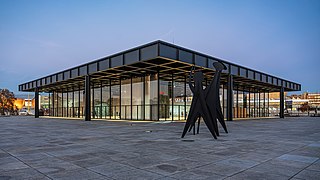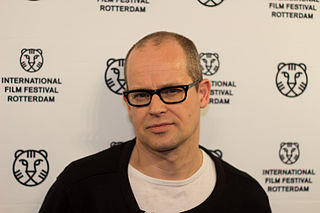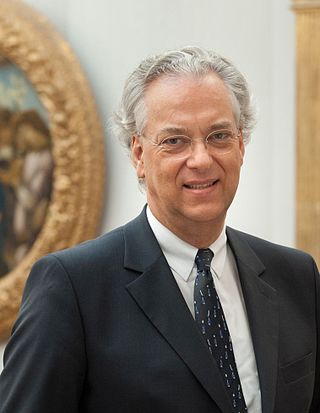| The Monument | |
|---|---|
 The sculpture in Berlin in 2016 | |
| Artist | Atelier Van Lieshout |
| Year | 2015 |

The Monument is a 2015 sculpture by Atelier Van Lieshout. It is part of the collection of Alte Nationalgalerie in Berlin, Germany. [1] [2]
| The Monument | |
|---|---|
 The sculpture in Berlin in 2016 | |
| Artist | Atelier Van Lieshout |
| Year | 2015 |

The Monument is a 2015 sculpture by Atelier Van Lieshout. It is part of the collection of Alte Nationalgalerie in Berlin, Germany. [1] [2]

The Neue Nationalgalerie at the Kulturforum is a museum for modern art in Berlin, with its main focus on the 20th century. It is part of the National Gallery of the Berlin State Museums. The museum building and its sculpture gardens were designed by Ludwig Mies van der Rohe and opened on September 15th, 1968.

The Egyptian Museum of Berlin is home to one of the world's most important collections of ancient Egyptian artefacts, including the iconic Nefertiti Bust. Since 1855, the collection is a part of the Neues Museum on Berlin's Museum Island, which reopened after renovations in 2009.

The Altes Museum is a listed building on the Museum Island in the historic centre of Berlin, Germany. Built between 1825 and 1830 by order of King Frederick William III of Prussia according to plans by Karl Friedrich Schinkel, it is considered a major work of German Neoclassical architecture. It is surrounded by the Berlin Cathedral to the east, the Berlin Palace to the south and the Zeughaus to the west. Currently, the Altes Museum houses the Antikensammlung and parts of the Münzkabinett. As part of the Museum Island complex, the Altes Museum was listed as a UNESCO World Heritage Site in 1999, in recognition of its testimony to the development of the museum as a social and architectural phenomenon.

Nikolaus Geiger was a German sculptor and painter.

Friedrich August Stüler was an influential Prussian architect and builder. His masterpiece is the Neues Museum in Berlin, as well as the dome of the triumphal arch of the main portal of the Berliner Schloss.

The Staatliche Museen zu Berlin are a group of institutions in Berlin, Germany, comprising seventeen museums in five clusters; several research institutes; libraries; and supporting facilities. They are overseen by the Prussian Cultural Heritage Foundation and funded by the German federal government in collaboration with Germany's federal states. The central complex on Museum Island was added to the UNESCO list of World Heritage Sites in 1999. By 2007, the Staatliche Museen zu Berlin had grown into the largest complex of museums in Europe. The museum was originally founded by King Friedrich Wilhelm III of Prussia in 1823 as the Königliche Museen.

Schloss Köpenick is a Baroque water palace of the Hohenzollern electors of Brandenburg which stands on an island in the Dahme River surrounded by an English-style park and gives its name to Köpenick, a district of Berlin.

The Kunstgewerbemuseum, or Museum of Decorative Arts, is an internationally important museum of the decorative arts in Berlin, Germany, part of the Staatliche Museen zu Berlin. The collection is split between the Kunstgewerbemuseum building at the Kulturforum (52°30′35″N13°22′03″E) and Köpenick Palace (52°26′38″N13°34′22″E).

The Kupferstichkabinett, or Museum of Prints and Drawings, is a prints museum in Berlin, Germany. It is part of the Berlin State Museums, and is located in the Kulturforum on Potsdamer Platz. It is the largest museum of graphic art in Germany, with more than 500,000 prints and around 110,000 individual works on paper.
The Zentralarchiv der Staatlichen Museen zu Berlin is an academic institution in Berlin, Germany, linked with the collections and administrative departments of the Staatliche Museen zu Berlin. It functions as the primary site for research and preservation of the museums' "memory" and their primary source documents. Its holdings span the history of the Staatliche Museen of today back to the former Königliche Museen of the Kingdom of Prussia and German Empire. Through consolidation, the holdings have become one of the most important art history archives in Germany.

Erik Gerardus Franciscus van Lieshout is a Dutch contemporary artist most widely known for his installations. In 2018, he won the Heineken Prize for Art.

Joep van Lieshout, is a Dutch artist and sculptor born in Ravenstein, Netherlands, and founder of Atelier Van Lieshout (AVL).

The Museum of Islamic Art is located in the Pergamon Museum and is part of the Staatliche Museen zu Berlin.

Die Humpty-Dumpty-Maschine der totalen Zukunft is a bronze sculpture created 2010 by Jonathan Meese, and installed at the Alte Nationalgalerie in Berlin, Germany, during 2011–2015.

The equestrian statue of Frederick William IV is an 1875–86 sculpture of Frederick William IV of Prussia by Alexander Calandrelli, installed in front of the Alte Nationalgalerie in Berlin, Germany.

Hercules and the Nemean Lion is a sculpture of Hercules fighting the Nemean lion by Max Klein, installed in the Kolonnadenhof outside the Alte Nationalgalerie in Berlin, Germany.

Hunne zu Pferde is a sculpture by Erich Hösel, installed outside the Alte Nationalgalerie in Berlin, Germany.

Michael Eissenhauer is a German art historian and was director-general of the Staatliche Museen zu Berlin.

Dahlem Museums is a complex in the Berlin-Dahlem district of Berlin. Its official address is at 8 Lansstraße, though its main entrance is at 25 Arnimallee. The earliest planning for the building was between 1914 and 1923, thanks to the efforts of Wilhelm von Bode and to designs by Bruno Paul. However, it was only eventually built between 1969 and 1973 to New Objectivity plans by Fritz Bornemann and Wils Ebert.